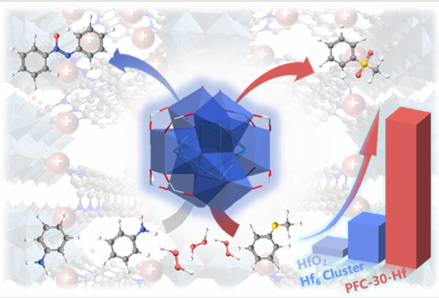In nature, organic reactions are predominantly catalyzed by enzymes, which demonstrate remarkable efficiency and exceptional selectivity. For decades, researchers have focused on designing structures to replicate enzymatic catalytic processes in both homogeneous and heterogeneous systems. Metal-organic frameworks (MOFs), characterized by high porosity, large surface area, and tunable structures, have emerged as ideal enzyme mimetics, finding extensive applications in heterogeneous catalysis. The catalytic performance of MOFs can be significantly enhanced through pore engineering strategies, including the modulation of metal nodes, organic building blocks, and topological structures.
In a study published in CCS Chemistry, a team led by Prof. LIU Tianfu from the Fujian Institute of Research on the Structure of Matter, Chinese Academy of Sciences, reported a novel and stable four-connected hafnium (Hf)-based cationic metal-organic framework (MOF), PFC-30-Hf, as a green catalyst for the catalytic synthesis of aniline to oxidize azo-benzene (AOB).
The researchers found that the PFC-30-Hf catalyzed the oxidation of aniline to azo-benzene (AOB) at room temperature using hydrogen peroxide (H2O2) as a green oxidant, exhibiting nearly 100% conversion and selectivity. Additionally, the product could be directly obtained via centrifugation after the reaction. The enhanced catalytic performance was attributed to the favorable microenvironment created in PFC-30-Hf by the Lewis acidic Hf⁴⁺ clusters, Brønsted acidic hydroxyl groups on the metal nodes, and the cationic ligands. This synergistic effect was verified through comparative experiments with the neutral MOF PFC-30-Hf-N, HfO2, and Hf6 clusters.
The researchers also revealed that the catalytic process proceeds via a mechanism involving stepwise oxygen atom transfer and intermediate condensation. Specifically, aniline is first oxidized to N-phenylhydroxylamine (NPHA), which is further oxidized to nitrobenzene (NSB), and finally, AOB is formed through the condensation reaction between NPHA and NSB. Furthermore, PFC-30-Hf demonstrated excellent catalytic activity and selectivity in the selective oxidation of sulfides, efficiently generating sulfone compounds. Further mechanistic studies excluded the involvement of O2, confirming that H2O2 is the sole oxidant in this reaction, and no radicals were generated during the process.
Experimental results indicated that PFC-30-Hf not only possesses high catalytic activity but also shows good recyclability and structural stability. After multiple cycles, both its catalytic activity and structural integrity remained virtually unchanged.
This study achieves efficient and selective oxidation reactions of aniline and sulfides, showcasing great potential in the field of green and sustainable chemistry, offering new insights for the development of multifunctional heterogeneous catalysts, and contributing to the synthesis of high-value-added fine chemicals.

PFC-30-Hf, as a green catalyst, is used for the oxidation of aniline to generate azo-benzene compounds (AOB).
Contact:
Prof. LIU Tianfu
Fujian Institute of Research on the Structure of Matter
Chinese Academy of Sciences
Email: tfliu@fjirsm.ac.cn